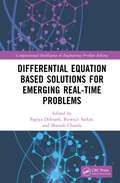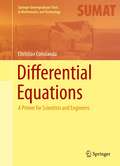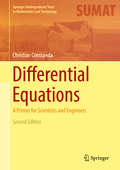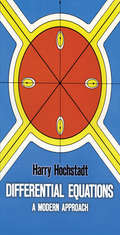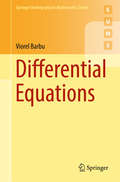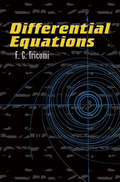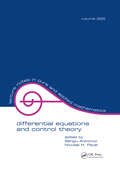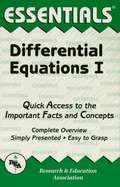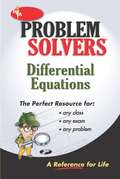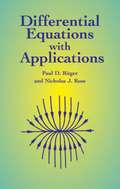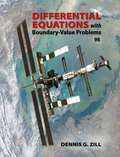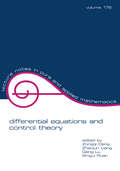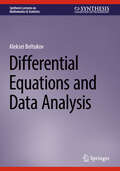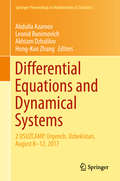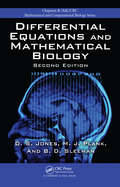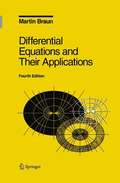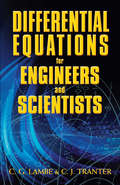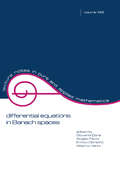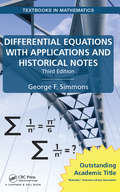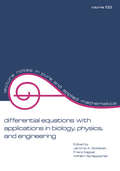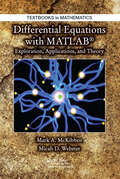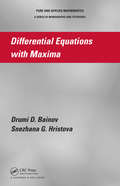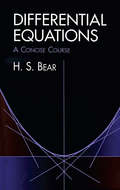- Table View
- List View
Differential Equation Based Solutions for Emerging Real-Time Problems (Computational Intelligence in Engineering Problem Solving)
by Biswajit Sarkar Manash Chanda Papiya DebnathModeling with differential equations is an effective tool to provide methodical and quantitative solutions to real-world phenomena including investigating measurable features, consolidation and processing of data, and designing and developing complex engineering systems. This book describes differential equations correlation with qualitative and quantitative analysis, and mathematical modeling in the engineering and applied sciences. Given equations are explained from multidimensional characterizations with MATLAB® codes. Features: Addresses differential equation-based approaches to solve varied engineering problems Discusses derivation and solution of major equations of engineering and applied science Reviews qualitative and quantitative (numerical) analysis and mathematical modelling Includes mathematical models of the discussed problems Discusses MATLAB® codes Features: code and online materials related to the differential equations. This book is aimed at researchers graduate students in electrical and electronics engineering, control systems, electron devices society, applied physics, and engineering design.
Differential Equations
by Christian ConstandaDifferential Equations for Scientists and Engineers is a book designed with students in mind. It attempts to take a concise, simple, and no-frills approach to differential equations. The approach used in this text is to give students extensive experience in main solution techniques with a lighter emphasis on the physical interpretation of the results. With a more manageable page count than comparable titles, and over 400 exercises that can be solved without a calculating device, this book emphasizes the understanding and practice of essential topics in a succinct fashion. At the end of each worked example, the author provides the Mathematica commands that can be used to check the results and where applicable, to generate graphical representations. It can be used independently by the average student, while those continuing with the subject will develop a fundamental framework with which to pursue more advanced material. This book is designed for undergraduate students with some basic knowledge of precalculus algebra and a first course in calculus.
Differential Equations
by Christian ConstandaDifferential Equations for Scientists and Engineers is a book designed with students in mind. It attempts to take a concise, simple, and no-frills approach to differential equations. The approach used in this text is to give students extensive experience in main solution techniques with a lighter emphasis on the physical interpretation of the results. With a more manageable page count than comparable titles, and over 400 exercises that can be solved without a calculating device, this book emphasizes the understanding and practice of essential topics in a succinct fashion. At the end of each worked example, the author provides the Mathematica commands that can be used to check the results and where applicable, to generate graphical representations. It can be used independently by the average student, while those continuing with the subject will develop a fundamental framework with which to pursue more advanced material. This book is designed for undergraduate students with some basic knowledge of precalculus algebra and a first course in calculus.
Differential Equations
by Harry HochstadtModern approach to differential equations presents subject in terms of ideas and concepts rather than special cases and tricks which traditional courses emphasized. No prerequisites needed other than a good calculus course. Certain concepts from linear algebra used throughout. Problem section at end of each chapter.
Differential Equations
by O.A. OleinikPart II of the Selected Works of Ivan Georgievich Petrowsky, contains his major papers on second order Partial differential equations, systems of ordinary. Differential equations, the theory, of Probability, the theory of functions, and the calculus of variations. Many of the articles contained in this book have Profoundly, influenced the development of modern mathematics. Of exceptional value is the article on the equation of diffusion with growing quantity of the substance. This work has found extensive application in biology, genetics, economics and other branches of natural science. Also of great importance is Petrowsky's work on a Problem which still remains unsolved - that of the number of limit cycles for ordinary differential equations with rational right-hand sides.
Differential Equations
by Viorel BarbuThis textbook is a comprehensive treatment of ordinary differential equations, concisely presenting basic and essential results in a rigorous manner. Including various examples from physics, mechanics, natural sciences, engineering and automatic theory, Differential Equations is a bridge between the abstract theory of differential equations and applied systems theory. Particular attention is given to the existence and uniqueness of the Cauchy problem, linear differential systems, stability theory and applications to first-order partial differential equations. Upper undergraduate students and researchers in applied mathematics and systems theory with a background in advanced calculus will find this book particularly useful. Supplementary topics are covered in an appendix enabling the book to be completely self-contained.
Differential Equations (Dover Books on Mathematics)
by F. G. Tricomi Elizabeth A. McHargBased on his extensive experience as an educator, F. G. Tricomi wrote this practical and concise teaching text to offer a clear idea of the problems and methods of the theory of differential equations. The treatment is geared toward advanced undergraduates and graduate students and addresses only questions that can be resolved with rigor and simplicity.Starting with a consideration of the existence and uniqueness theorem, the text advances to the behavior of the characteristics of a first-order equation, boundary problems for second-order linear equations, asymptotic methods, and differential equations in the complex field. The author discusses only ordinary differential equations, excluding coverage of the methods of integration and stressing the importance of reading the properties of the integrals directly from the equations. An extensive bibliography and helpful indexes conclude the text.
Differential Equations And Control Theory
by Nicolae H. Pavel Sergiu AizicoviciProvides comprehensive coverage of the most recent developments in the theory of non-Archimedean pseudo-differential equations and its application to stochastics and mathematical physics--offering current methods of construction for stochastic processes in the field of p-adic numbers and related structures. Develops a new theory for parabolic equations over non-Archimedean fields in relation to Markov processes.
Differential Equations I Essentials
by The Editors of REAREA's Essentials provide quick and easy access to critical information in a variety of different fields, ranging from the most basic to the most advanced. As its name implies, these concise, comprehensive study guides summarize the essentials of the field covered. Essentials are helpful when preparing for exams, doing homework and will remain a lasting reference source for students, teachers, and professionals. Differential Equations I covers first- and second-order equations, series solutions, higher-order linear equations, and the Laplace transform.
Differential Equations Problem Solver
by David ArterbumREA's Problem Solvers is a series of useful, practical, and informative study guides. Each title in the series is complete step-by-step solution guide. The Differential Equations Problem Solver enables students to solve difficult problems by showing them step-by-step solutions to Differential Equations problems. The Problem Solvers cover material ranging from the elementary to the advanced and make excellent review books and textbook companions. They're perfect for undergraduate and graduate studies. The Differential Equations Problem Solver is the perfect resource for any class, any exam, and any problem.
Differential Equations With Applications
by Paul D. Ritger Nicholas J. RoseCoherent introductory text focuses on initial- and boundary-value problems, general properties of linear equations, and differences between linear and nonlinear systems. Answers to most problems.
Differential Equations With Boundary-value Problems
by Dennis ZillMaster differential equations and succeed in your course DIFFERENTIAL EQUATIONS WITH BOUNDARY-VALUE PROBLEMS with accompanying CD-ROM and technology! Straightfoward and readable, this mathematics text provides you with tools such as examples, explanations, definitions, and applications designed to help you succeed. The accompanying DE Tools CD-ROM makes helps you master difficult concepts through twenty-one demonstration tools such as Project Tools and Text Tools. Studying is made easy with iLrn Tutorial, a text-specific, interactive tutorial software program that gives the practice you need to succeed.
Differential Equations and Control Theory
by Zongqi Deng; Zhaojun Liang; Gang Lu; Shigui RuanThis work presents the proceedings from the International Conference on Differential Equations and Control Theory, held recently in Wuhan, China. It provides an overview of current developments in a range of topics including dynamical systems, optimal control theory, stochastic control, chaos, fractals, wavelets and ordinary, partial, functional and stochastic differential equations.
Differential Equations and Data Analysis (Synthesis Lectures on Mathematics & Statistics)
by Aleksei BeltukovThis book is focused on modeling with linear differential equations with constant coefficients. The author starts with the elementary natural growth equation and ends with the heat equation on the real line. The emphasis is on linear algebra, Fourier theory, and specifically data analysis, which is given a very prominent role and is often the book's main driving force. All aspects of modeling with linear differential equations are illustrated by analyzing real and simulated data in MATLAB®. These modeling case studies are of particular interest to students who anticipate having to use differential equations in their fields. The book is self-contained and is appropriate as a supplement for a first course in differential equations whose prerequisites include proficiency in multivariate calculus and MATLAB literacy.
Differential Equations and Dynamical Systems: 2 USUZCAMP, Urgench, Uzbekistan, August 8–12, 2017 (Springer Proceedings in Mathematics & Statistics #268)
by Leonid Bunimovich Abdulla Azamov Akhtam Dzhalilov Hong-Kun ZhangThis book features papers presented during a special session on dynamical systems, mathematical physics, and partial differential equations. Research articles are devoted to broad complex systems and models such as qualitative theory of dynamical systems, theory of games, circle diffeomorphisms, piecewise smooth circle maps, nonlinear parabolic systems, quadtratic dynamical systems, billiards, and intermittent maps. Focusing on a variety of topics from dynamical properties to stochastic properties of dynamical systems, this volume includes discussion on discrete-numerical tracking, conjugation between two critical circle maps, invariance principles, and the central limit theorem. Applications to game theory and networks are also included. Graduate students and researchers interested in complex systems, differential equations, dynamical systems, functional analysis, and mathematical physics will find this book useful for their studies. The special session was part of the second USA-Uzbekistan Conference on Analysis and Mathematical Physics held on August 8-12, 2017 at Urgench State University (Uzbekistan). The conference encouraged communication and future collaboration among U.S. mathematicians and their counterparts in Uzbekistan and other countries. Main themes included algebra and functional analysis, dynamical systems, mathematical physics and partial differential equations, probability theory and mathematical statistics, and pluripotential theory. A number of significant, recently established results were disseminated at the conference’s scheduled plenary talks, while invited talks presented a broad spectrum of findings in several sessions. Based on a different session from the conference, Algebra, Complex Analysis, and Pluripotential Theory is also published in the Springer Proceedings in Mathematics & Statistics Series.
Differential Equations and Mathematical Biology (Chapman & Hall/CRC Mathematical Biology Series)
by Michael Plank B.D. Sleeman D.S. JonesDeepen students' understanding of biological phenomenaSuitable for courses on differential equations with applications to mathematical biology or as an introduction to mathematical biology, Differential Equations and Mathematical Biology, Second Edition introduces students in the physical, mathematical, and biological sciences to fundamental modeli
Differential Equations and Numerical Analysis
by Valarmathi Sigamani John J. H. Miller Ramanujam Narasimhan Paramasivam Mathiazhagan Franklin VictorThis book offers an ideal introduction to singular perturbation problems, and a valuable guide for researchers in the field of differential equations. It also includes chapters on new contributions to both fields: differential equations and singular perturbation problems. Written by experts who are active researchers in the related fields, the book serves as a comprehensive source of information on the underlying ideas in the construction of numerical methods to address different classes of problems with solutions of different behaviors, which will ultimately help researchers to design and assess numerical methods for solving new problems. All the chapters presented in the volume are complemented by illustrations in the form of tables and graphs.
Differential Equations and Their Applications: An Introduction to Applied Mathematics (Fourth Edition)
by F. John Jerrold E. Marsden Martin Golubitsky W. Jager Lawrence Sirovich Martin BraunUsed in undergraduate classrooms across the USA, this is a clearly written, rigorous introduction to differential equations and their applications. Fully understandable to students who have had one year of calculus, this book distinguishes itself from other differential equations texts through its engaging application of the subject matter to interesting scenarios. This fourth edition incorporates earlier introductory material on bifurcation theory and adds a new chapter on Sturm-Liouville boundary value problems. Computer programs in C, Pascal, and Fortran are presented throughout the text to show readers how to apply differential equations towards quantitative problems.
Differential Equations for Engineers and Scientists (Dover Books on Mathematics)
by C. G. Lambe C. J. TranterThis concise applications-oriented text is intended for undergraduate students in engineering, mathematics, and other areas of science. The first chapters focus on solutions of first order equations, linear equations with constant coefficients, and simultaneous equations and reducible equations. Subsequent chapters explore the method of solution by infinite series and the more important special functions of mathematical physics. The treatment examines the solution of partial differential equations as well as numerical methods of solution, including that of relaxation. Readers also receive an introduction to the theory of nonlinear differential equations. Nearly 900 worked examples and exercises include complete solutions, making this volume ideal for self-study as well as an excellent classroom text.
Differential Equations in Banach Spaces
by Giovanni Dore; Angelo Favini; Enrico Obrecht; Alberto VenniThis reference - based on the Conference on Differential Equations, held in Bologna - provides information on current research in parabolic and hyperbolic differential equations. Presenting methods and results in semigroup theory and their applications to evolution equations, this book focuses on topics including: abstract parabolic and hyperbolic linear differential equations; nonlinear abstract parabolic equations; holomorphic semigroups; and Volterra operator integral equations.;With contributions from international experts, Differential Equations in Banach Spaces is intended for research mathematicians in functional analysis, partial differential equations, operator theory and control theory; and students in these disciplines.
Differential Equations with Applications and Historical Notes (Textbooks in Mathematics)
by George F. SimmonsFads are as common in mathematics as in any other human activity, and it is always difficult to separate the enduring from the ephemeral in the achievements of one’s own time. An unfortunate effect of the predominance of fads is that if a student doesn’t learn about such worthwhile topics as the wave equation, Gauss’s hypergeometric function, the gamma function, and the basic problems of the calculus of variations—among others—as an undergraduate, then he/she is unlikely to do so later. The natural place for an informal acquaintance with such ideas is a leisurely introductory course on differential equations. Specially designed for just such a course, Differential Equations with Applications and Historical Notes takes great pleasure in the journey into the world of differential equations and their wide range of applications. The author—a highly respected educator—advocates a careful approach, using explicit explanation to ensure students fully comprehend the subject matter. With an emphasis on modeling and applications, the long-awaited Third Edition of this classic textbook presents a substantial new section on Gauss’s bell curve and improves coverage of Fourier analysis, numerical methods, and linear algebra. Relating the development of mathematics to human activity—i.e., identifying why and how mathematics is used—the text includes a wealth of unique examples and exercises, as well as the author’s distinctive historical notes, throughout. Provides an ideal text for a one- or two-semester introductory course on differential equations Emphasizes modeling and applications Presents a substantial new section on Gauss’s bell curve Improves coverage of Fourier analysis, numerical methods, and linear algebra Relates the development of mathematics to human activity—i.e., identifying why and how mathematics is used Includes a wealth of unique examples and exercises, as well as the author’s distinctive historical notes, throughout Uses explicit explanation to ensure students fully comprehend the subject matter Outstanding Academic Title of the Year, Choice magazine, American Library Association.
Differential Equations with Applications in Biology, Physics, and Engineering (Lecture Notes In Pure And Applied Mathematics Ser. #133)
by GoldsteinSuitable as a textbook for a graduate seminar in mathematical modelling, and as a resource for scientists in a wide range of disciplines. Presents 22 lectures from an international conference in Leibnitz, Austria (no date mentioned), explaining recent developments and results in differential equatio
Differential Equations with MATLAB: Exploration, Applications, and Theory (Textbooks in Mathematics)
by Mark McKibben Micah D. WebsterA unique textbook for an undergraduate course on mathematical modeling, Differential Equations with MATLAB: Exploration, Applications, and Theory provides students with an understanding of the practical and theoretical aspects of mathematical models involving ordinary and partial differential equations (ODEs and PDEs). The text presents a unifying
Differential Equations with Maxima
by Drumi D. Bainov Snezhana G. HristovaDifferential equations with "maxima"-differential equations that contain the maximum of the unknown function over a previous interval-adequately model real-world processes whose present state significantly depends on the maximum value of the state on a past time interval. More and more, these equations model and regulate the behavior of various tec
Differential Equations: A Concise Course
by H. S. BearThis concise treatment of differential equations is intended to serve as a text for a standard one-semester or two-term undergraduate course in differential equations following the calculus. Emphasis is placed on mathematical explanations -- ranging from routine calculations to moderately sophisticated theorems -- in order to impart more than a rote understanding of techniques.Beginning with a survey of first order equations, the text goes on to consider linear equations -- including discussions of complex-valued solutions, linear differential operators, inverse operators, and variation of parameters method. Subsequent chapters then examine the Laplace transform and Picard's existence theorem and conclude with an exploration of various interpretations of systems of equations.Numerous clearly stated theorems and proofs, examples, and problems followed by solutions make this a first-rate introduction to differential equations.
